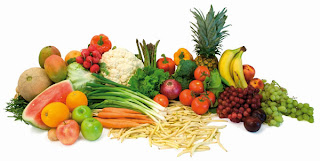This post has become a topic since 400 BC the Greek physician Hippocrates when he wrote something like: "Let food be your medicine and medicine be your food". This is because during the ancient times, when physicians can only predict that consuming food will help to cure our illness and regenerating our body in better shape. They do not know what nutritions are! However, this became a relatively simple question today, with which a 10 year-old kids should be able to explain it to you: because vegetable is a good source of vitamins and will make us healthier. But why is consuming vegetable making our life healthier? We definitely need some more concrete evidence rather than just saying it is beneficial for human.
Caption: fruits and vegetables
There are strong evidences stating that vegetables are good source of dietry fibre. Remember, fibre can only be found in plants (and sometimes in some fibre suppliments). Some examples are pectin, beta-glucans, hemicellulose, cellulose, lignin, fructans, and gums. All these components are important in human nutrition. They are sometimes recognised as soluble fibre.
Okay, this section is important. I think it is also important to explain in a little detail here. There are 2 types of fibre (1) insoluble fibre and (2) soluble fibre. Insoluble fibre are fibre foods that we consume but cannot be digested. So insoluble fibre that we consume will have one function, that is to pass through the bowel (bowel is referred to the long tube in the body of a person where food moves during digestion), helping other foods and waste to be digested easier. Some examples of insoluble fibre products are brown rice, wholegrain bread/biscuit, cereal, fruits and vegetables. Since insoluble fibre also helps to stop constipation, consuming insoluble fibre will make us feel full easily so we will most likely not eating much food after consuming them. On the other hand, soluble fibre refers to dissolvable in water, but cannot be digested. Soluble fibres may help reducing the amount of cholestrol in our blood. Instead, it absorbs water from our body to form as gelatinous substances that passes through our body. Some examples of soluble fibre products are oat and beans. We should also not forget to consume plenty of water after eating foods enriched with fibre, else we might encounter trouble going to the washroom and/or feeling not well in the stomach area.
Besides that, consuming plenty of soluble fibres will help preventing colon cancer (cancer in the large intestine that serves to remove water from digested food, and allowing waste materials (such as stool) to move through it to leave our body), heart disease and diabetes, as reported by the World Health Organization (WHO) - eating only vegetables should save around 26 million people in 2005. This was also proven by the 'Journal of the American Medical Association' in 2006. Additional evidence supporting this fact is that 49, 000 females wee used as a subject in some experiment, had proven that consuming vegetables frequently reduces the risks of breast cancer, colon cancer and heart disease.
Caption: what is vegetable?
Other than that, scientists have proven that meats are sometimes important for our body. For example, some of the components of vitamin B could only be found in pork. This means that the vitamin B complex suppliment will only provide most B vitamins that a person's body require, and not all. You may also read more about vitamin B here (click HERE). Anyway, please choose the correct meat to eat if you are meat eaters. In any cases, we should strongly restrict ourselves from eating cud chewing animals since it was proven worst meat compared grain/grass-fed animals. Some examples of cud chewing animals are goats, sheep, giraffes, bison, water buffalo, deer, camels and antelope. Cud chewing means a portion of food that returns from the stomach in the mouth to be chewed for the second time. I read it from New Scientist once, stating that eating kangaroos are way much better than eating chicken and/or pork!
There is also a statement where was stated by the WHO that the chronic disease is expected to account for 75% of all deaths worldwide by the mid of 21st century. Chronic disease is referred to some diseases that are long lasting or recurrent. Some examples of chronic diseases are heart disease, stroke, cancer, respiratory and diabetes. So, consuming vegetables daily will definitely overcome these problems.
Caption: meats
There is another good reason to consume vegetables and fruits rather than meat. Apart from being healthy, eating vegetables are definitely better for the environment. Therefore, the National Cancer Institute and American Diabetes Association recommended us to consume at least 20 – 35 grams of high fibre foods everyday. The united states department of agriculture (USDA) also suggests a dietry guideline of 5 to 9 servings of fruits and vegetables everyday. A minimum of 1.5 whole grain food serving everyday is recommended for babies of around 3 years old. The recommended figure of 3 to 6 whole grain serving is recommended for people of age 9 and above. An example of 1 serving of fruits/vegetables is consuming a glass of 100% fruit or vegetable juice.
Caption: fruits and vegetables
Here is a simple figure provided by the USDA in 2005, rougly describe the dietry foods a person should consume, and the fibre contained in the food:
100grams of conflakes is to 29.33 grams of fibre
100grams of cooked beans / seeds without salt is to 10.49 grams of fibre
100 grams of wheat flour / whole grain is to 12.17 grams of fibre
100 grams of dried dates is to 7.98 grams of fibre
100 grams of candies / sweet chocolates is to 5.89 grams of fibre
100 grams of tomato products without salt is to 4.50 grams of fibre
100 grams of soyabean without salt is to 5.99 grams of fibre
You may also prefer reading different but clearer and more detailed dieting portions here (click HERE).
HOW A SIMPLE DECISION CHANGES MY OUTLOOK
7 years ago

0 comments:
Post a Comment